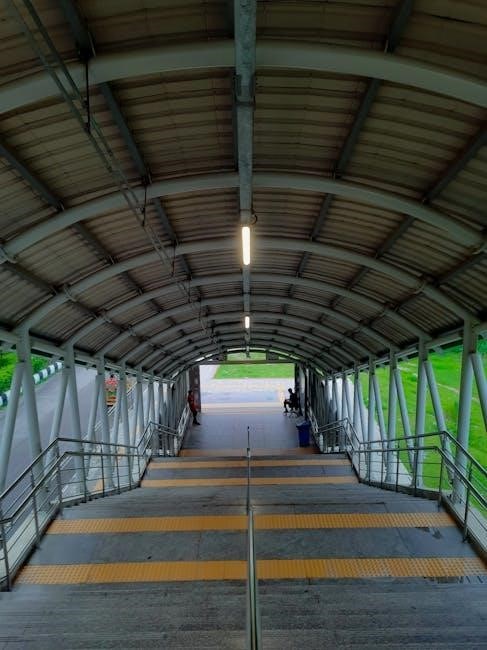Guide railings are essential structures ensuring safety and support in various environments, offering stability and preventing accidents in public spaces, staircases, and walkways while integrating functionality with design.
Overview of Guide Railing
Guide railings are structures designed to provide support, safety, and guidance in various environments. They typically consist of vertical posts, handrails, and brackets, forming a barrier that prevents accidents and ensures stability. These railings are commonly installed along staircases, walkways, balconies, and platforms. Their primary function is to protect individuals from falls and injuries while offering a secure handhold for navigation. Guide railings are also used to direct pedestrian flow and enhance accessibility in public and private spaces. Made from durable materials like metal, wood, or glass, they are both functional and aesthetically pleasing, blending seamlessly into modern and traditional designs. Their presence is crucial for ensuring safety and compliance with building codes.
Purpose and Importance of Guide Railing
Guide railings serve as critical safety features, primarily designed to prevent falls and injuries by providing a secure handhold and physical barrier. Their purpose extends to offering stability and support, particularly in areas with uneven terrain, stairs, or heights. They are essential for ensuring accessibility, guiding pedestrians, and enhancing mobility for all individuals, including those with disabilities. In public spaces, guide railings play a vital role in crowd control and directional guidance, reducing accidents and improving overall safety. Their importance lies in their ability to protect lives while complying with international building codes and accessibility standards. By integrating functionality with design, guide railings contribute to safer, more accessible environments in both residential and commercial settings.
Common Applications of Guide Railing
Guide railings are widely used in various settings to ensure safety and accessibility. They are commonly installed along staircases, walkways, and ramps to provide support and prevent slips or falls. In public spaces such as shopping malls, hospitals, and airports, guide railings serve as essential components for crowd control and directional guidance. Residential areas, including balconies and porches, also benefit from their installation for enhanced safety and aesthetic appeal. Additionally, guide railings are used in industrial environments to protect workers and equipment, and in vehicles like buses and trains to ensure passenger safety. Their versatility and functionality make them a crucial feature in both indoor and outdoor environments, promoting accessibility and reducing risks in diverse applications.

Types of Guide Railings
Guide railings come in various materials, each offering distinct benefits. Stainless steel, aluminum, and glass are popular choices, differing in durability, aesthetic appeal, and suitability for different environments.
Stainless Steel Guide Railings
Stainless steel guide railings are renowned for their exceptional durability and corrosion resistance, making them ideal for both indoor and outdoor applications. They offer a modern, sleek appearance while providing strong structural support. Their ability to withstand harsh weather conditions and heavy use ensures longevity. Stainless steel railings are often used in commercial and industrial settings due to their load-bearing capacity and low maintenance requirements. They can be customized to fit various designs, blending seamlessly with contemporary architecture. The material’s resilience to rust and fading ensures they retain their aesthetic appeal over time. Stainless steel guide railings are a practical and stylish choice for ensuring safety and stability in diverse environments.
Aluminum Guide Railings
Aluminum guide railings are a popular choice due to their lightweight, corrosion-resistant, and durable nature. They are often used in both indoor and outdoor settings, offering a sleek and modern appearance. Aluminum railings are versatile, allowing for customization to suit various architectural styles. Their resistance to rust and weathering makes them ideal for outdoor applications, such as balconies, staircases, and walkways. They are also low maintenance, requiring minimal upkeep to retain their appearance. Aluminum guide railings are widely used in residential and commercial spaces, providing structural support while enhancing the aesthetic appeal of the area. Their lightweight design makes them easy to install, and they are cost-effective compared to other materials. Aluminum railings are a practical and stylish solution for safety and durability in diverse environments.
Glass Guide Railings

Glass guide railings offer a sleek, modern aesthetic and are ideal for applications where transparency and unobstructed views are desired. Made from toughened glass, these railings provide durability and safety, making them suitable for balconies, staircases, and public spaces. Glass railings are often combined with metal or aluminum frames for structural support, though frameless designs are also popular for a minimalist look. They are easy to maintain, as glass surfaces can be cleaned effortlessly. Glass guide railings are a perfect choice for residential and commercial settings, blending functionality with contemporary design. Their transparency enhances natural light and creates a sense of openness, making them a preferred option for architects and homeowners seeking modern solutions for safety and style.
Design Considerations for Guide Railings
Design considerations for guide railings focus on balancing aesthetics, functionality, and safety. Factors include material selection, load capacity, and integration with architectural styles to ensure durability and visual appeal.
Load-Bearing Capacity and Structural Integrity
Load-bearing capacity and structural integrity are critical factors in guide railing design. Railings must withstand external forces, such as weight and pressure, while maintaining stability. Materials like stainless steel and aluminum are preferred for their strength and durability. Proper installation ensures the railing can support the required load without compromising safety. Building codes often specify minimum load-bearing requirements, particularly in commercial and public spaces. Regular inspections and testing are essential to verify structural integrity and identify potential weaknesses. Durable materials and precise engineering ensure railings remain reliable over time, providing consistent support and safety in various environments. This balance between strength and functionality is vital for long-term performance and user trust.
Aesthetic Design and Modern Architecture Integration

Guide railings play a dual role by combining functionality with modern aesthetics. Their sleek designs and versatile materials, such as glass, stainless steel, and aluminum, seamlessly integrate into contemporary architecture. Architects often prioritize railings that complement building design, ensuring visual harmony while maintaining safety. Minimalist profiles and clean lines are popular choices for modern spaces, offering both durability and style. Customizable options allow railings to adapt to various architectural themes, from industrial to residential settings. The ability to blend functionality with visual appeal makes guide railings an essential element in enhancing both safety and the overall esthetic experience of a space. This integration ensures they remain a key feature in modern construction and design trends.

Installation and Maintenance of Guide Railings
Proper installation ensures stability and safety, while regular maintenance prevents wear and tear. Inspect for damage, tighten loose parts, and clean surfaces to uphold functionality and appearance.
Best Practices for Installation
Proper installation of guide railings ensures safety and durability. Begin with precise measurements and secure anchoring to withstand weight and stress. Ensure all components are aligned correctly and follow manufacturer guidelines for hardware placement. Use high-quality materials and tools to prevent defects. Post-installation, inspect the railing for stability and test its load-bearing capacity. Address any gaps or misalignments promptly. Regularly check for loose parts and tighten them as needed. Adhere to local building codes and safety standards to guarantee compliance. Proper installation not only enhances functionality but also extends the lifespan of the railing system, providing reliable support and protection in various settings.

Maintenance Tips for Longevity

Regular maintenance is crucial for extending the lifespan of guide railings. Start with routine cleaning to remove dirt, grime, and contaminants using mild detergents and water. Avoid harsh chemicals that may damage materials. Inspect the railings periodically for loose components, rust, or wear and tear, addressing issues promptly. Tighten fasteners and replace damaged parts immediately. For metal railings, apply a protective coating or paint to prevent corrosion. Lubricate moving parts, such as hinges, to ensure smooth operation. For glass railings, use specialized cleaners to maintain clarity. Keep documentation of maintenance activities to track progress and ensure compliance. By following these tips, guide railings remain durable, safe, and visually appealing over time.

Safety Standards and Compliance
Guide railings must comply with international building codes, ensuring structural integrity and safety. Materials undergo rigorous testing to meet regulatory requirements, guaranteeing reliability and public safety.
International Building Codes and Regulations
Guide railings must adhere to stringent international building codes, such as the International Building Code (IBC) and European Norms (EN), ensuring structural integrity and safety. These regulations specify load-bearing capacities, material durability, and installation guidelines to prevent accidents. Compliance involves rigorous testing of materials, including stress tests and durability assessments, to meet safety standards. Proper installation practices are also mandated, requiring certified professionals to follow precise guidelines. Design elements, such as railing height and spacing, are dictated by these codes to optimize user safety. Regular inspections and maintenance are further required to ensure ongoing compliance. By aligning with these regulations, guide railings provide reliable support and protection in diverse environments.
Material Compliance and Testing
Material compliance and testing are critical to ensure guide railings meet safety and durability standards. Tests such as tensile strength, corrosion resistance, and impact resistance are conducted to verify material integrity. Stainless steel, aluminum, and glass must pass rigorous evaluations to withstand environmental and structural stresses. Certification processes involve third-party inspections to confirm adherence to international standards. These tests guarantee that materials can support designated loads and endure harsh conditions. Compliance ensures reliability and longevity, minimizing risks of failure. Regular testing also validates the suitability of materials for specific applications, ensuring safety and performance over time.
Applications and Case Studies
Guide railings are widely used in public spaces, transportation hubs, and commercial buildings, enhancing safety and accessibility while blending seamlessly into modern design aesthetics.

Commercial and Residential Applications
Guide railings are extensively used in commercial settings like office buildings, shopping malls, hospitals, and airports to ensure safety and crowd management. In residential areas, they are installed in staircases, balconies, and patios to provide support and enhance aesthetics. These railings are designed to withstand heavy use in commercial spaces while offering a sleek, modern look for homes. Materials like stainless steel and aluminum are popular choices due to their durability and versatility. Additionally, guide railings in residential properties often integrate with interior design trends, creating a seamless blend of functionality and style. Their presence contributes significantly to accessibility and safety in both commercial and residential environments.
Industrial and Specialized Applications
Guide railings are crucial in industrial settings, such as factories, warehouses, and construction sites, where they provide safety barriers near machinery or hazardous areas. In specialized environments like marine vessels, stadiums, or healthcare facilities, these railings ensure secure pathways and protection. Industrial railings are often designed with heavy-duty materials to withstand harsh conditions, while specialized applications may require custom designs for unique challenges. For instance, in healthcare, antimicrobial coatings are used to enhance hygiene. These railings also guide workflows in industrial zones and protect equipment from damage. Their versatility and durability make them indispensable in maintaining safety and efficiency across diverse industrial and specialized settings.
Case Studies and Success Stories
Guide railings have proven their effectiveness in various real-world applications, showcasing their adaptability and safety benefits. For instance, a large stadium project utilized stainless steel guide railings to ensure crowd safety while maintaining a modern aesthetic. In a hospital setting, glass railings were installed to provide visibility and cleanliness, enhancing patient and staff safety. Industrial facilities have reported reduced workplace accidents by implementing heavy-duty guide railings near machinery. These success stories highlight how guide railings can be tailored to meet specific needs, ensuring both functionality and compliance with safety standards. Their durability and versatility have made them a reliable choice across diverse industries, demonstrating their long-term value and effectiveness in real-world scenarios.

